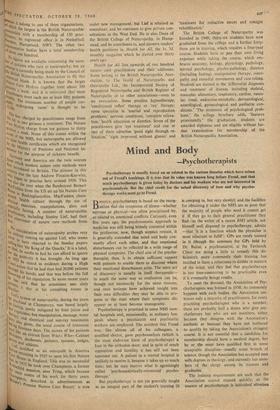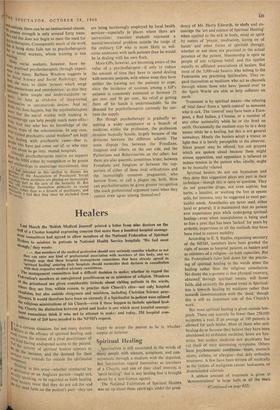t .
.' I i fill 1' '11 1'01.1 •
, $ .1
The growth of the railways opened up 11)Yrigd°rk - - Production soared—but, then so di e °11ll10,i, Someone remarked, 'It pays to advertise. A centres of population. United Healers' Day has now established itself as an annual feature of London life. The Royal Albert Hall and the Royal Festival Hall have been booked for these occasions and have been filled. These London demonstrations begin with organ music, the singing of a hymn or two, and solos from an opera singer. Speeches are made, perhaps by an MP and a sympathetic Anglican or Methodist clergyman. Then the sick and the lame in the audience are invited to go, one by one, on to the platform to receive treatment. Patients may be turned away because of unsuitability for public demonstration — hernia sufferers — but otherwise they are accepted as they come: cripples, curvatures of the spine, the blind, the deaf, the arthritic, spastics.
These demonstrations have one obvious draw- back: they attract many more people than can possibly be attended to in the time available, .co:sufferers are picked out not so much at random as because they seem likely, at a quick glance, to be good subjects for demonstration purposes. The straightening of a curved spine, for example, or the restoration of the ability to walk can be easily grasped by the audience and has an electrifying effect. Sceptics may object that it is all a monstrous fake; but doctors are welcome to go on to the platform and examine patients both before and after treatment, and there is no record that any doctor has detected the demonstrators in any trickery. a month. Its approach to healing is to try to fuse the scientific and the spiritual. Clergymen, doctors, psychiatrists and nurses are all joined together in membership. They practise their healing ministry by means of the 'laying on of hands,' anointing the sick with holy oil, prayers and contemplative meditation.
The Guild is unable to say how many people are associated with it in its work; but it has about 250 prayer groups in corporate membership and these come from all the Churches except Rome. Its monthly magazine has a circulation of more than 4.000 copies, and over forty corporate groups were added last year.
Just as in the Church of England itself there are differences of opinion on doctrine and ritual, so there has been a hiving-off by some of the Guild members, converted to the notion of .t ministry of healing. In 1915 the Guild of St. Raphael was formed to serve the Anglo-Catholic wing; and there is the London Healing Mission, founded by the Rev. John Maillard, less domin- ated by Harley Street than is the Guild of Health. It has a prayer list of 1,000 intercessors. Its News Letter goes to 5,500 subscribers, and about 4,000 clergymen of many persuasions are among its members. Other ministries of healing are those carried on by Miss Dorothy Kerin at Burrswood, Kent, and the Rev. George Bennett's Divine Healing Mission at Crowhurst, Sussex.
Most Anglican diocesan bishops actively en-















































 Previous page
Previous page